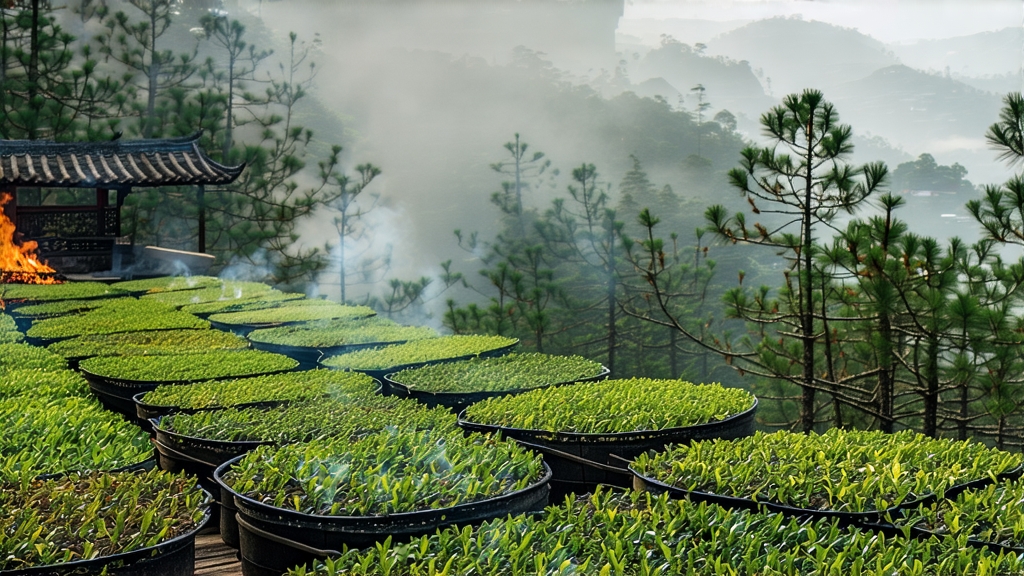
If you trace the family tree of every bold, copper-coloured cup that English breakfast blends, Indian Assams and Kenyan teas now pour, you will arrive at one mist-wrapped ridge in the Wuyi Mountains of northern Fujian. There, sometime around the late Ming dynasty (mid-1600s), monks and farmers accidentally invented the world’s first fully oxidised leaf—what the Chinese still call hong cha, “red tea,” and what the West learned to label “black.” That original tea is Lapsang Souchong, a name that carries the smoky perfume of pine needles and the sweet memory of camel caravans that once carried it across Eurasia.
1. Historical echoes
Local lore speaks of a Qing army unit passing through Tongmu village during the tea-picking season. To prevent the fresh leaves from spoiling, villagers rushed them through withering and drying over the nearest available fuel—green pine logs. The resulting intensely aromatic tea surprised the Dutch traders who first tasted it at the port of Xiamen; they christened it “bohea” (a corruption of “Wuyi”) and shipped it to Amsterdam in 1604. By the early 1700s Lapsang Souchong had become the most expensive lot at the London auctions, outbidding green teas and inspiring the English to attempt their own black tea plantations in India.
2. Terroir and leaf grade
Authentic Lapsang Souchong can only be produced inside the 600–1 200 m core zone of the Wuyi National Nature Reserve, a UNESCO mixed heritage site where subtropical monsoon clouds collide with granite cliffs. The cultivar of choice is xiao zhong (“small cultivar”), a slow-growing shrub whose young spring buds contain unusually high levels of geraniol and linalool—volatile compounds that later marry with pine smoke to create the tea’s signature “longan and pipe-tobacco” note.
Within the grade hierarchy, the top tier is called “Wild High Peak,” hand-picked from semi-wild trees scattered above 1 000 m. Below it come “Premium Tongmu,” “Smoked Special,” and the stronger “Russian Caravan” style blended for export. The critical difference is not leaf size but smoking technique: the higher the elevation, the gentler the smoke, allowing the honeyed fruit character to dominate.
3. Crafting smoke with precision
Unlike common assumptions, Lapsang Souchong is not simply tossed into a bonfire. The process follows meticulous steps refined over four centuries:
Withering: Fresh leaves are laid on bamboo screens inside wooden lofts heated only by residual warmth from the ground-floor firing pit. Over eight hours the moisture drops from 75 % to 60 %, softening cells for rolling.
Rolling: A 45-minute machine roll breaks leaf walls; enzymes meet oxygen and the oxidation clock starts.
Oxidation: Leaves rest 3–4 hours in wooden trays kept at 24 °C and 80 % humidity. The colour shifts from jade to mahogany, while grassy aromatics convert into malty theaflavins.
Pan-firing: A quick 220 °C tumble for two minutes halts oxidation at 90 %, locking in sweetness.
Smoking & drying: Here lies the art. Pinus taiwanensis and massoniana logs, still resinous but stripped of bark, are stacked in a sunken hearth. A bamboo sieve holding the tea sits one metre above the flame, allowing only cool, aromatic smoke to circulate. Masters adjust the distance, draught and timing every 15 minutes; too close and the tea becomes bitter creosote, too far and the fragrance is weak. Two smoking passes of 20 minutes each, separated by a 30-minute rest, yield the classic balance.
Sorting & ageing: Final stems and flakes are removed, then the tea is rested for at least 30 days in cedar-lined chests so smoke integrates with the leaf. Connoisseurs often cellar small batches for three years; the smoke softens while dried longan and dark cocoa notes emerge.
4. Brewing: gongfu versus Western
To taste the subtle layers hidden behind the campfire aroma, water quality is paramount—use neutral spring water at 95 °C.
Gongfu style (preferred):
- 5 g leaf in a 120 ml zisha or porcelain gaiwan.
- Quick rinse, then 8 infusions: 5 s, 5 s